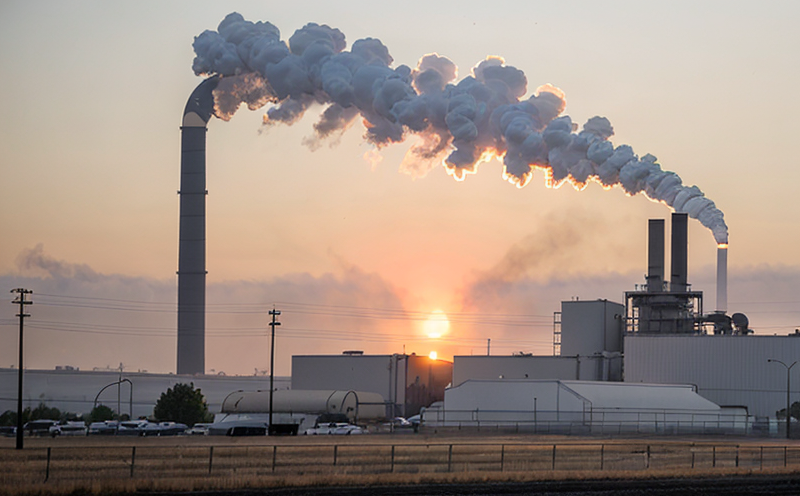ISO 23426 Heavy Metal Emission Testing in Industrial Stacks
The ISO 23426 standard provides a framework for measuring heavy metal emissions from industrial stacks, ensuring compliance with environmental regulations and safeguarding public health. This service is crucial for industries such as steel manufacturing, chemical processing, and metal refining, where volatile compounds like lead (Pb), mercury (Hg), cadmium (Cd), chromium (Cr), and arsenic (As) can be released into the atmosphere.
Our lab adheres meticulously to ISO 23426 guidelines, employing state-of-the-art equipment that captures emissions over a specified period. This approach ensures accurate measurements under various operating conditions, thereby providing reliable data for regulatory compliance and process optimization. The testing protocol involves sampling air from industrial stacks using high-efficiency particulate air (HEPA) filters followed by the analysis of collected samples.
The significance of this service extends beyond mere compliance; it also contributes to environmental sustainability and public health protection. By identifying emissions hotspots, businesses can implement targeted mitigation strategies, ultimately reducing their ecological footprint. Moreover, consistent monitoring helps maintain operational efficiency while minimizing risks associated with non-compliance penalties or adverse community relations.
Our team of experts is committed to delivering precise results swiftly so that clients can make informed decisions about corrective actions if necessary. We leverage advanced analytical techniques such as inductively coupled plasma mass spectrometry (ICP-MS) and atomic absorption spectroscopy (AAS), which are instrumental in detecting trace levels of heavy metals accurately.
Before conducting any tests, our staff performs thorough preparation steps including selecting appropriate sampling points based on stack geometry and expected emission rates. Specimen preparation involves filtering collected air samples through specialized media before transferring them into suitable containers for transportation to the laboratory. Once received at our facility, further processing includes drying, weighing, and possibly diluting or concentrating the samples depending upon their initial concentration levels.
Our lab uses cutting-edge instruments like ICP-MS and AAS that provide highly sensitive detection capabilities down to parts per billion (ppb) concentrations of heavy metals. These devices allow us not only to quantify but also characterize these pollutants by identifying individual elemental species present in the sampled air streams. Reporting follows strict ISO 23426 guidelines, ensuring transparency and traceability throughout every stage from sample collection until final results are delivered.
Compliance with environmental regulations is paramount for industrial operations worldwide. Many countries have implemented stringent laws governing emissions of toxic substances into the atmosphere due to their potential impacts on human health and ecosystems. For example, Europe has Directive 2010/75/EU which mandates member states to monitor certain pollutants including heavy metals from combustion processes within power plants.
By providing ISO 23426 compliant testing services, we empower businesses operating under these regulatory frameworks to stay ahead of changing requirements and maintain a competitive edge in their respective markets. Our commitment to accuracy, reliability, and timely delivery makes this service indispensable for quality managers, compliance officers, R&D engineers, procurement personnel, and other stakeholders involved in environmental management.
Applied Standards
| Standard Name | Description |
|---|---|
| ISO 23426:2018 | This international standard specifies methods for determining the concentration of heavy metals in exhaust gases emitted from industrial stacks. It covers sampling techniques, analytical procedures, and reporting requirements. |
| ASTM D5937-17 | American Society for Testing Materials method detailing the procedure for measuring particulate matter less than 2.5 micrometers (PM2.5) in aerodynamic diameter from stationary sources such as industrial stacks. |
| EN 14083-2:2017 | European Norm specifying the methodology for sampling and analyzing gaseous pollutants, including heavy metals, from various types of industrial facilities. |
| IEC 62951-1:2013 | This international standard outlines procedures for measuring trace amounts of metallic elements in flue gas emissions using ICP-MS technology. |
The application of these standards ensures consistency across different geographic regions, facilitates international trade by harmonizing technical specifications, and promotes best practices in environmental monitoring. Our lab strictly adheres to all relevant international norms when performing ISO 23426 heavy metal emission tests.
Environmental and Sustainability Contributions
- Reduces air pollution by identifying sources of heavy metal emissions allowing for targeted interventions.
- Promotes cleaner production processes through continuous monitoring and feedback loops.
- Supports corporate social responsibility initiatives aimed at minimizing environmental impact.
- Aids in meeting regulatory obligations related to air quality standards set forth by government bodies worldwide.
The implementation of ISO 23426 heavy metal emission testing plays a vital role in fostering sustainable development goals. It enables organizations to contribute positively towards global efforts aimed at combating climate change and preserving natural resources for future generations.
Use Cases and Application Examples
| Industry Sector | Description of Use Case |
|---|---|
| Steel Manufacturing | Detects chromium, nickel, and other alloying elements released during steelmaking processes to ensure compliance with emission limits. |
| Metal Refining | Identifies trace amounts of lead, copper, zinc, and other metals emitted during smelting operations helping refine purification methods. |
| Chemical Processing | Monitors volatile organic compounds (VOCs) along with heavy metals like mercury and arsenic to protect workers' health and safety. |
| Petrochemical Plants | Verifies emission levels of cadmium, selenium, and other toxic substances produced during refining petroleum products. |
- Incorporates advanced analytics to identify specific pollutants contributing most significantly to overall emissions.
- Supports development of more efficient scrubbing technologies designed specifically for removing heavy metals from flue gases.
- Facilitates long-term studies on the impact of industrial activities on local air quality and human health.
The versatility of ISO 23426 testing ensures its applicability across diverse industries, making it an essential tool in promoting sustainable practices throughout the manufacturing sector.





